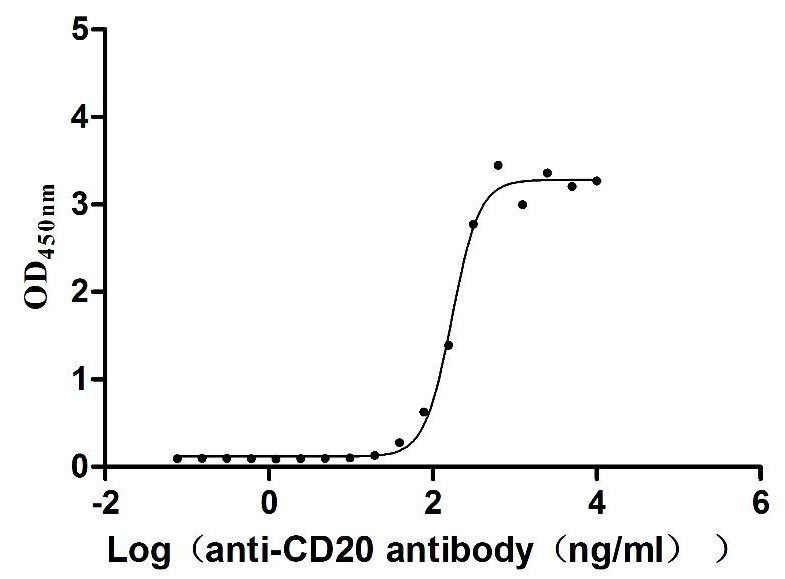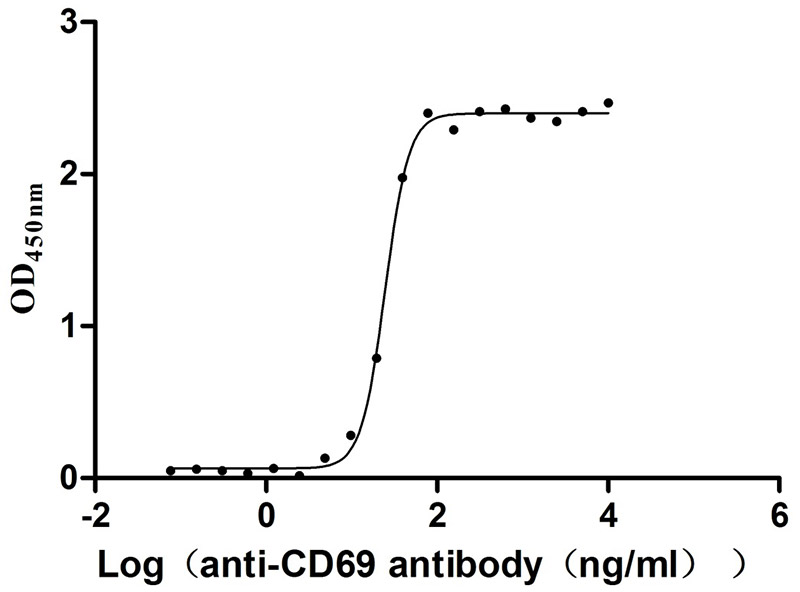Recombinant Mouse Protein DJ-1 (Park7)
-
货号:CSB-YP859979MO
-
规格:
-
来源:Yeast
-
其他:
-
货号:CSB-EP859979MO
-
规格:
-
来源:E.coli
-
其他:
-
货号:CSB-EP859979MO-B
-
规格:
-
来源:E.coli
-
共轭:Avi-tag Biotinylated
E. coli biotin ligase (BirA) is highly specific in covalently attaching biotin to the 15 amino acid AviTag peptide. This recombinant protein was biotinylated in vivo by AviTag-BirA technology, which method is BriA catalyzes amide linkage between the biotin and the specific lysine of the AviTag.
-
其他:
-
货号:CSB-BP859979MO
-
规格:
-
来源:Baculovirus
-
其他:
-
货号:CSB-MP859979MO
-
规格:
-
来源:Mammalian cell
-
其他:
产品详情
-
纯度:>85% (SDS-PAGE)
-
基因名:
-
Uniprot No.:
-
别名:Park7; Protein/nucleic acid deglycase DJ-1; EC 3.1.2.-; EC 3.5.1.-; EC 3.5.1.124; Maillard deglycase; Parkinson disease protein 7 homolog; Parkinsonism-associated deglycase; Protein DJ-1; DJ-1
-
种属:Mus musculus (Mouse)
-
蛋白长度:Cytoplasmic domain
-
表达区域:-
-
蛋白标签:Tag type will be determined during the manufacturing process.
The tag type will be determined during production process. If you have specified tag type, please tell us and we will develop the specified tag preferentially. -
产品提供形式:Lyophilized powder
Note: We will preferentially ship the format that we have in stock, however, if you have any special requirement for the format, please remark your requirement when placing the order, we will prepare according to your demand. -
复溶:We recommend that this vial be briefly centrifuged prior to opening to bring the contents to the bottom. Please reconstitute protein in deionized sterile water to a concentration of 0.1-1.0 mg/mL.We recommend to add 5-50% of glycerol (final concentration) and aliquot for long-term storage at -20℃/-80℃. Our default final concentration of glycerol is 50%. Customers could use it as reference.
-
储存条件:Store at -20°C/-80°C upon receipt, aliquoting is necessary for mutiple use. Avoid repeated freeze-thaw cycles.
-
保质期:The shelf life is related to many factors, storage state, buffer ingredients, storage temperature and the stability of the protein itself.
Generally, the shelf life of liquid form is 6 months at -20°C/-80°C. The shelf life of lyophilized form is 12 months at -20°C/-80°C. -
货期:Delivery time may differ from different purchasing way or location, please kindly consult your local distributors for specific delivery time.Note: All of our proteins are default shipped with normal blue ice packs, if you request to ship with dry ice, please communicate with us in advance and extra fees will be charged.
-
注意事项:Repeated freezing and thawing is not recommended. Store working aliquots at 4°C for up to one week.
-
Datasheet :Please contact us to get it.
相关产品
靶点详情
-
功能:Multifunctional protein with controversial molecular function which plays an important role in cell protection against oxidative stress and cell death acting as oxidative stress sensor and redox-sensitive chaperone and protease. It is involved in neuroprotective mechanisms like the stabilization of NFE2L2 and PINK1 proteins, male fertility as a positive regulator of androgen signaling pathway as well as cell growth and transformation through, for instance, the modulation of NF-kappa-B signaling pathway. Has been described as a protein and nucleo...显示更多
-
基因功能参考文献:
- DJ-1 protein concentration was significantly increased during the clinical phase in cerebrospinal fluid of sporadic Creutzfeldt-Jakob disease patients. PMID: 27975168
- The molecular mechanism linking miR-221 to genetic forms of Parkinson's disease (PD) has not been studied. Consistent with the microarray data, miR-221 expression is also decreased in DJ-1(-/-) mouse brains. Re-introduction of wild-type DJ-1, but not its PD-linked pathogenic M26I mutant, restores miR-221 expression. PMID: 30107296
- the results of this study suggest that male DJ-1 KO mice exhibit defects in brown adipose tissue (BAT) activity but do not gain more weight, revealing that BAT activity is not necessarily required for predisposing DJ-1 KO mice to obesity. Therefore, therapeutic targeting of DJ-1 in BAT could provide novel insights into the treatment of obesity. PMID: 30142366
- Results suggest that protein deglycase DJ-1 (DJ-1) plays a role in bone homeostasis in normal physiology and in bone-associated pathology by negatively regulating osteoclastogenesis. PMID: 29142196
- Silencing the DJ-1 gene uncovers a link between mitochondria-associated Parkinson's disease and mitotic pressure. PMID: 29097687
- Low DJ-1 expression impairs synaptic vesicle endocytosis and reavailability at nerve terminals. PMID: 29386384
- DJ-1 deficiency causes defects in astrocyte-mediated repair of brain damage. PMID: 29105838
- In cultured neurons and forebrain samples from Dj1(-/-) animals, there was chloride damage and a profound structural remodeling of the mitochondrial respiratory chain. PMID: 28408307
- DJ-1 has a role in glutamate uptake into astrocytes by regulating flotillin-1 and caveolin-1 expression PMID: 27346864
- Network analysis reveals DJ-1/LDLR as common host proteins modulating pathogenesis of neurotropic viruses. PMID: 27581498
- Induction of DJ-1 may serve as a novel regulator for hepatocellular carcinoma cell proliferation and HCC development possibly through enhanced MAPK signaling and inflammation. PMID: 28036277
- chaperone-mediated autophagy protects mitochondrial function by degrading nonfunctional PARK7 and maintaining its homeostasis, and dysregulation of this pathway may contribute to the neuronal stress and death in Parkinson disease pathogenesis PMID: 27171370
- Knockdown of DJ-1 attenuates Nurr1 activity. PMID: 26873851
- These results demonstrate that DJ-1 KO mice display progressive signs of retinal/RPE degeneration in association with higher levels of oxidative stress markers. Collectively this analysis indicates that DJ-1 plays an important role in protecting photoreceptors and RPE from oxidative damage during aging PMID: 28088625
- DJ-1 activates autophagy to alleviate cardiac hypertrophy. PMID: 28941803
- These results indicate that up-regulation of GH in the lungs of DJ-1 KO mice may enhance the malignancy of B16F10 cells and nodule formation in pulmonary metastasis of melanoma. PMID: 27825319
- DJ-1 deficiency negatively regulates liver progenitor cells (LPC) proliferation by impairing the formation of LPC-associated fibrosis and inflammatory niches. PMID: 27277679
- regulation of reactive oxygen species (ROS) and of the antioxidant protein DJ-1 (PARK-7), which increases with cancer progression and acts to lessen oxidative damage to malignant cells, in relationship with systemic mastocytosis severity, was examined. PMID: 27611333
- Our data strengthen previous findings regarding DJ-1 diverse pathways and indicate that DJ-1 is part of a concerted and complex cellular response to OS PMID: 27109140
- Our data demonstrates that the activation of DJ-1 in response to myocardial I/R injury protects the heart by regulating the SUMOylation status of Drp1 and attenuating excessive mitochondrial fission. PMID: 27108530
- DJ-1(-/-) astrocytes may provide decreased neuroprotection to surrounding neurons due to alterations in pro-inflammatory mediator expression PMID: 26691871
- Loss of DJ-1 impairs antioxidant response by altered glutamine and serine metabolism. PMID: 26836693
- To verify our finding, we provide evidence that the protein expression of Parkinson protein 7, including new protein synthesis, is sensitive to mTORC1 inhibition PMID: 26419955
- this study identified the anti-oxidant protein DJ-1 as being capable of protecting pancreatic islet cells from cell death induced by an inflammatory and cytotoxic setting. PMID: 26422139
- In skeletal muscle cells, DJ-1 contributes to undernutrition-induced atrophy via MAPKs/ubiquitin ligase pathway. PMID: 26408915
- Deficiency of DJ-1 exerts a stimulatory effect on vascular smooth muscle cell migration. PMID: 25978603
- DJ1 maintains cellular metabolic homeostasis via modulating ROS levels in murine skeletal muscles, revealing a role of DJ1 in maintaining efficient fuel utilization. PMID: 26077864
- DJ-1 physically binds the 20S proteasome and inhibits its activity. following oxidative stress, DJ-1 is involved in the Nrf2-dependent oxidative stress response that leads to the upregulation of both the 20S proteasome and its regulator, NQO1. PMID: 25833141
- The Park7 has a protective role against sepsis by controlling macrophage activation, NADPH oxidase activation and inflammation responses. PMID: 26021615
- in addition to detailing the visual defects that occur as a result of the absence of DJ-1, our data is also relevant to AMD pathogenesis. PMID: 26215528
- DJ-1 reinforces the PI3K/AKT survival pathway and inhibits autophagy, probably by a mechanism independent from mTOR. PMID: 26222260
- High DJ-1 contributes to adipogenesis and obesity-induced inflammation. PMID: 24925581
- the P158Delta point mutation may contribute to neurodegeneration by protein destabilization and hence loss of DJ-1 function. PMID: 23241025
- DJ-1 appears to have a protective role against dopaminergic degeneration triggered by alpha-syn or 6-OHDA, reinforcing the possible therapeutic importance of this protein in Parkinson's disease. PMID: 25500798
- results indicate that DJ1 regulates cell metabolism and proliferation through Pink1 PMID: 25670069
- Thus, our results suggest that myricitrin alleviates MPP(+)-induced mitochondrial dysfunction and increases cell viability via DJ-1. PMID: 25623535
- Data suggest that Parkinson's disease protein DJ-1 is a common physiological sensor involved in both nutrition-induced effects and neurodegenerative disease states. PMID: 24646099
- results suggest that DJ-1 protein is involved in SDF-1-induced CD3+ T cell migration via the overexpression of the CXCR4 receptor and that DJ-1 might act as an inhibitory regulator in vascular remodeling such as neointima formation PMID: 24953490
- DJ-1 protein regulates the expression of renal PRR through H2O2-mediated epigenetic modification. PMID: 25463323
- Brains from DJ-1(-/-) mice showed an increase in mitochondrial Trx activity, GSH and GSSG levels and mitochondrial glutaredoxin (GRX) activity. PMID: 24936441
- The purpose of this study was to investigate the effects of PARK7 in muscle growth and protein accretion in response to IGF1. PMID: 24637782
- DJ-1/park7 protein may be implicated in the regulation of vascular contractility and blood pressure PMID: 24323315
- DJ-1 knockout mice were more susceptible to cell death from in vivo ischemic reperfusion injury with larger myocardial infarct sizes and resistance to cardioprotection by ischemic preconditioning. PMID: 24577080
- oxidative stress-mediated intracellular trafficking of DJ-1, mediated by dynamic DJ-1 dimeric/monomeric cycling, is implicated in Parkinson disease pathogenesis. PMID: 24912681
- is thought to be an oxidative sensor that protects cells from oxidative insult. PMID: 24269020
- These observations suggest the relevance of DJ-1 oxidation to homeostasis in multiple brain regions, including neuromelanin-containing neurons of the substantia nigra PMID: 24918637
- Data show the transcriptional activation of the cholecystokinin gene by DJ-1 through interaction of DJ-1 with RREB1 and the effect of DJ-1 on the cholecystokinin level. PMID: 24348900
- Results show DJ-1 protein associated with lipid rafts. This novel function of DJ-1 in lipid rafts, may contribute the pathogenesis of Parkinson's Disease. PMID: 23847046
- the mortalin/DJ-1 complex guards against mitochondrial oxidative stress and is indispensable for the maintenance of hematopoietic stem cells PMID: 24243970
- The Parkinson disease-related protein DJ-1 counteracts mitochondrial impairment induced by the tumour suppressor protein p53 by enhancing endoplasmic reticulum-mitochondria tethering. PMID: 23418303
收起更多
-
亚细胞定位:Cell membrane; Lipid-anchor. Cytoplasm. Membrane raft. Nucleus. Mitochondrion. Endoplasmic reticulum.
-
蛋白家族:Peptidase C56 family
-
组织特异性:Expressed in erythroblasts and in mature red blood cells from peripheral blood (at protein level). In pancreas, expression is higher in islets than surrounding exocrine tissues.
-
数据库链接:
KEGG: mmu:57320
STRING: 10090.ENSMUSP00000030805
UniGene: Mm.277349

















